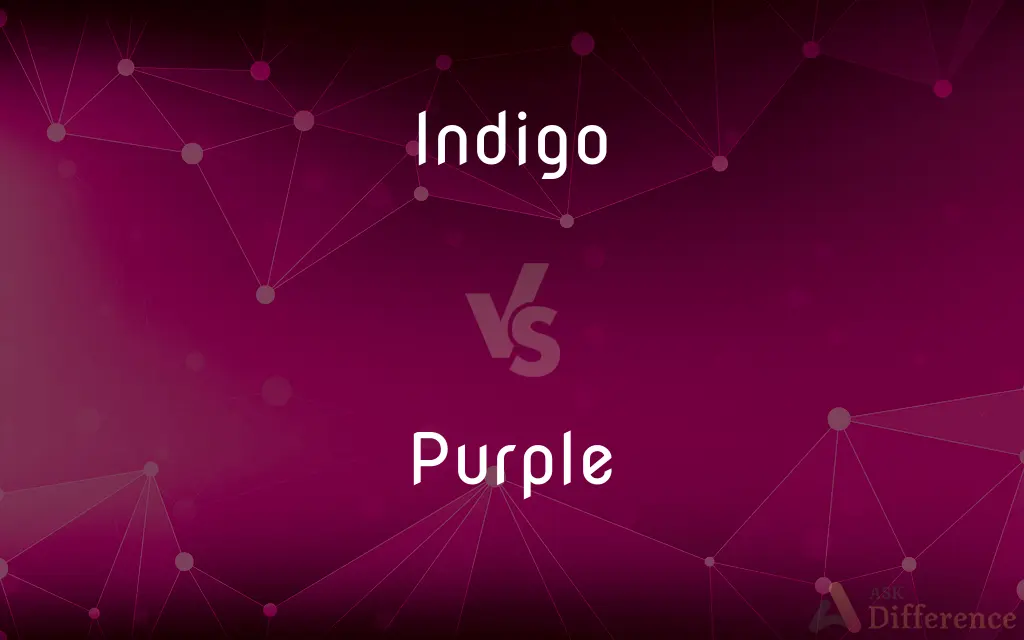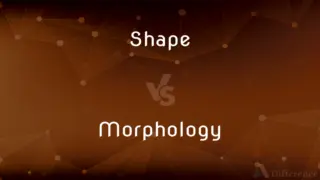Indigo vs. Purple — What's the Difference?
By Tayyaba Rehman & Urooj Arif — Updated on March 1, 2024
Indigo is a deep blue-violet color, traditionally seen as a spectrum color between blue and violet, while purple encompasses a broader range of hues between red and blue, often appearing more reddish.

Difference Between Indigo and Purple
Table of Contents
ADVERTISEMENT
Key Differences
Indigo is often described as a deep, rich color that sits on the spectrum between blue and violet. It is traditionally considered one of the seven colors of the rainbow, named and identified by Isaac Newton. Indigo leans more towards blue and is sometimes hard to distinguish from navy blue or deep violet. Its specific shade is reminiscent of the dye originally produced from the indigo plant, which has a characteristic deep blue-violet appearance.
Purple, in contrast, is a general term for the range of hues that result from a mix of red and blue. This means that purple encompasses a wide variety of shades, from light lavenders to deep plums. Purple does not have a specific place in the spectrum of light visible to the human eye; instead, it is a composite color made by combining wavelengths at both ends of the visible spectrum. Purples can vary significantly in their appearance, often appearing more reddish compared to indigo's deep blue-violet hue.
The distinction between indigo and purple primarily lies in their composition and the visual impact each color presents. Indigo's identity is closely tied to its historical and natural dye origins, giving it a specific shade that is often associated with depth and stability. Purple's identity, however, is more versatile, symbolizing royalty, luxury, and creativity, thanks to its broad palette range and less specific definition.
Indigo is sometimes included in the broader category of purple hues, while it is distinguished by its closer association with blue. On the other hand, purples can shift significantly towards red, offering a warmer appearance compared to the cooler, more introspective shade of indigo.
Comparison Chart
Definition
A deep blue-violet color, between blue and violet in the spectrum.
A range of hues combining red and blue, not specifically in the spectrum.
ADVERTISEMENT
Composition
Closer to blue, with a hint of violet.
Mix of red and blue, with a wide range of shades from reddish to bluish.
Origin
Named after the indigo dye from the indigo plant.
No specific natural origin; composite color.
Symbolism
Often associated with depth, stability, and integrity.
Represents royalty, luxury, creativity, and sometimes mystery.
Visibility
Considered part of the visible spectrum traditionally.
A composite color, not a single wavelength in the visible spectrum.
Examples
The color of the night sky just after sunset.
Ranges from lavender to plum, including amethyst and mauve.
Compare with Definitions
Indigo
A deep blue-violet color, traditionally part of the rainbow.
The artist used indigo to capture the twilight sky.
Purple
A color mixing red and blue, varying widely in hue.
The garden was full of flowers ranging from light to dark purple.
Indigo
A color that appears almost black in low light.
The indigo ink appeared black but revealed its color in sunlight.
Purple
Symbolizes royalty and luxury.
The purple velvet robe was fit for a king.
Indigo
The color resembling the dye from the indigo plant.
Her dress was dyed in a rich shade of indigo.
Purple
A broad category of hues, not a single wavelength.
Her favorite color palette includes a variety of purples.
Indigo
Symbolic of depth and intuition.
Indigo in the painting evokes a sense of mystery.
Purple
Can be warm or cool, depending on the mix.
The room was painted in a warm shade of purple.
Indigo
Positioned between blue and violet in the spectrum.
Indigo is often debated in its distinction from blue and violet.
Purple
Not part of the traditional rainbow colors, but widely recognized.
Purple is often associated with creativity and imagination.
Indigo
Indigo is a deep color close to the color wheel blue (a primary color in the RGB color space), as well as to some variants of ultramarine, based on the ancient dye of the same name. The word "indigo" comes from the Latin for Indian as the dye was originally exported to Europe from India.
Purple
Purple may refer to any of a variety of colors with hue between red and blue. However, the meaning of the color term purple differs even among native speakers of English, for example when comparing speakers from the United Kingdom with those from the United States )..
Indigo
Any of various shrubs or herbs of the genus Indigofera in the pea family, having pinnately compound leaves and usually red or purple flowers in axillary racemes.
Purple
A colour intermediate between red and blue
The painting was mostly in shades of blue and purple
Indigo
A dark blue crystalline compound, C16H10N2O2, that is obtained from these plants or produced synthetically and is widely used as a textile dye. Also called indigotin.
Purple
Any of a group of colors with a hue between that of violet and red.
Indigo
An indigo-colored dye obtained from certain plants (the indigo plant or woad), or a similar synthetic dye.
Purple
Cloth of a color between violet and red, formerly worn as a symbol of royalty or high office.
Indigo
A kind of deep blue, one of the seven prismatic colors.
Purple
A color that is a dark blend of red and blue; dark magenta.
Indigo
Having the color of, pertaining to, or derived from, indigo.
Purple
A color formed by, or resembling that formed by, a combination of the primary colors red and blue.
Arraying with reflected purple and goldThe clouds that on his western throne attend.
Indigo
A blue dye obtained from plants or made synthetically
Purple
A chromatic color between red and blue
Purple
Become purple
Common Curiosities
Is indigo more blue or purple?
Indigo is more blue, with a hint of violet, making it lean towards the cooler end of the spectrum.
Why is purple considered a color of royalty?
Purple is associated with royalty due to its historical rarity and the expense of producing purple dyes, which were once available only to wealthy individuals.
Which is darker, indigo or purple?
Indigo is typically perceived as darker, with a depth that can resemble the night sky, while purple encompasses a broader range that includes both light and dark hues.
How is purple made in art and design?
In art and design, purple is created by mixing red and blue pigments or using color blending techniques in digital media.
How has the perception of indigo changed over time?
The perception of indigo has evolved, especially as distinctions between colors have become more refined with advances in science and art.
Can the human eye easily distinguish indigo from blue and violet?
While some people can easily distinguish indigo as a separate color, others may find it challenging to differentiate it from dark blue or violet due to its position in the spectrum.
What cultural meanings does purple hold?
Beyond royalty and luxury, purple is also associated with feminism, LGBTQ+ pride, and spiritual awareness in various cultures.
Can indigo and purple be used interchangeably?
While both can be categorized broadly under purple hues, their distinct shades and meanings often make them non-interchangeable in specific contexts.
How is indigo dye produced?
Indigo dye is traditionally extracted from the leaves of certain plant species, particularly those in the genus Indigofera.
What makes purple a composite color?
Purple is considered a composite color because it is not found as a single wavelength in the visible spectrum but is made by combining red and blue light.
Do indigo and purple have different psychological effects?
Yes, indigo is often associated with depth, intuition, and stability, while purple is linked to creativity, luxury, and sometimes spirituality, influencing their psychological impact.
Are there any natural sources of purple besides dyes?
Natural sources of purple include flowers, fruits, and minerals, although historically, true purple dyes were rare and prized for their beauty and cost.
Are there any colors that blend well with both indigo and purple?
Both colors pair well with shades of gray, white, and silver, offering contrasting palettes that highlight their depth and richness.
What historical significance does indigo have?
Indigo has a rich history, especially in trade and textile industries, where it was a highly valued dye for its strong, vibrant color and durability.
Why do some people exclude indigo from the rainbow?
Some exclude indigo, arguing that the distinctions among blue, indigo, and violet are too subtle for the rainbow's division into seven distinct colors to be practical.
Share Your Discovery

Previous Comparison
Shape vs. Morphology
Next Comparison
Scarf vs. ShawlAuthor Spotlight
Written by
Tayyaba RehmanTayyaba Rehman is a distinguished writer, currently serving as a primary contributor to askdifference.com. As a researcher in semantics and etymology, Tayyaba's passion for the complexity of languages and their distinctions has found a perfect home on the platform. Tayyaba delves into the intricacies of language, distinguishing between commonly confused words and phrases, thereby providing clarity for readers worldwide.
Co-written by
Urooj ArifUrooj is a skilled content writer at Ask Difference, known for her exceptional ability to simplify complex topics into engaging and informative content. With a passion for research and a flair for clear, concise writing, she consistently delivers articles that resonate with our diverse audience.














































